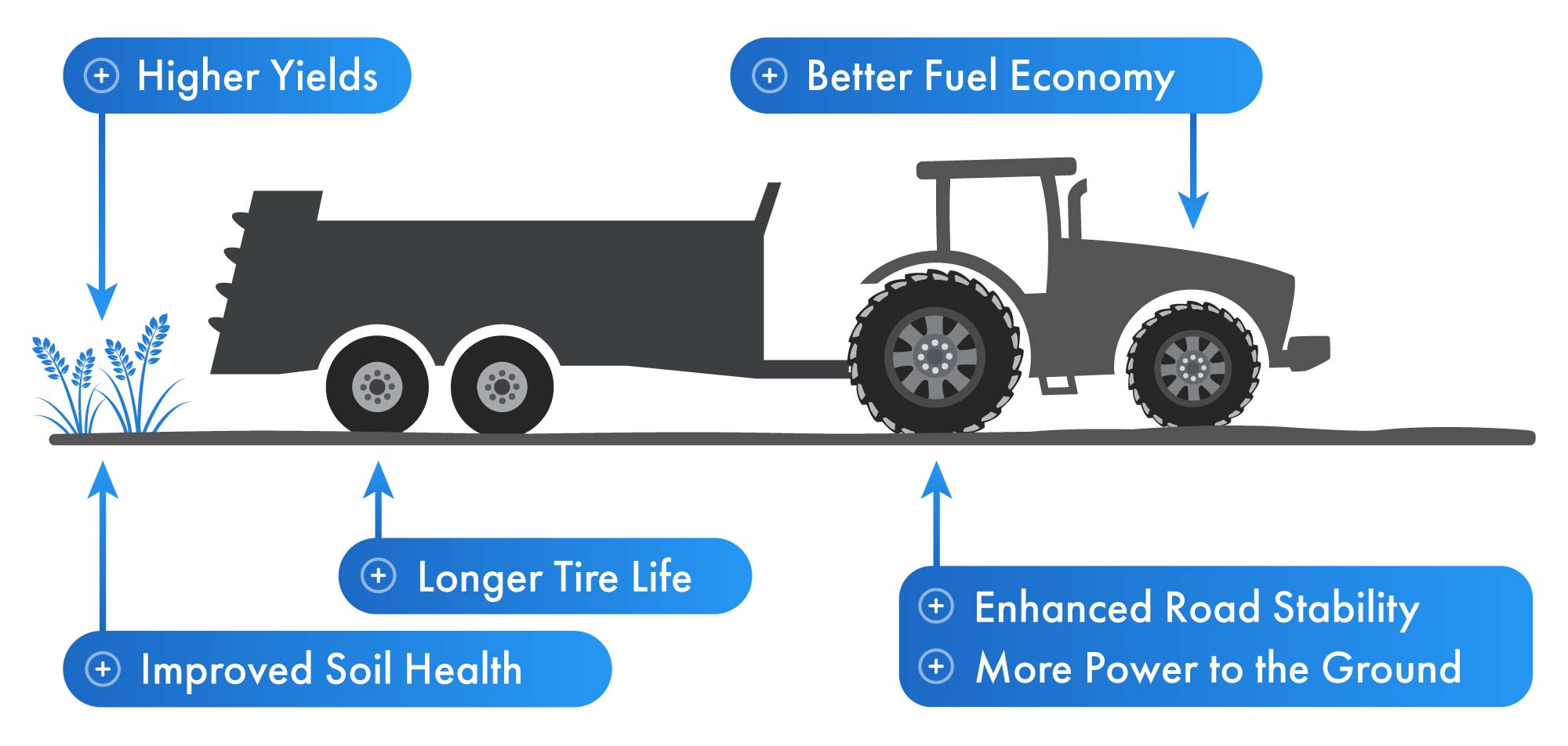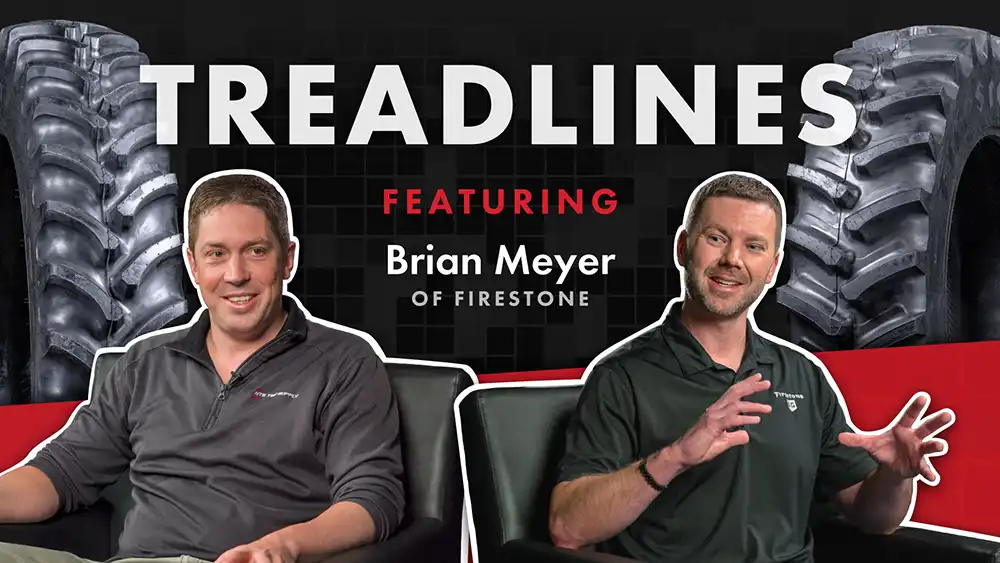Because agriculture is an industry that’s always innovating, farmers today have more tire choices than ever before. The need to eliminate (or at least minimize) harmful deep-soil compaction has driven tire companies to produce IF and VF radials, LSW super singles, and revolutionary designs that combine the advantages of tires and tracks. Even with all this innovation, there’s still one limiting factor to optimizing a tire’s performance: air pressure. No matter how much technology your tires pack, if you’re running them across your fields at pressures that are higher than necessary for the load you’re carrying and the speed you’re traveling, your fields are at risk for deep-soil compaction.

The chart below shows the results of a decade-long study measuring yield loss from deep soil compaction. As you can see, the soil compaction that occurred on year one slashed yields for more than a decade. When margins are tight, you need every bushel in your grain tank. And sometimes getting more bushels is as simple as running with the right tire air pressure.

Take the Pressure Off Your Fields and Boost Your Yields with a Central Tire Inflation System
If you subject your fields to deep-soil compaction, your yields and profitability will start to suffer in year one. And then, the negative effects of tightly packed soil can carry through for a decade or longer. This very problem has fueled the rise of central tire inflation systems (CTIS) across Europe, with some farm equipment manufacturers offering them as standard equipment from the factory.
We'd like to introduce you to central tire inflation systems by PTG, which will allow you to take advantage of your tires’ abilities to handle high loads in road gear and minimize compaction in the field.
Avoid A Common Tire Tactic that Costs You Money
To operate your equipment safely, you have to set your tire pressures, on both your tractor and implements, for the worst case scenario you’re going to face for the day. For most growers, this means setting tire pressures for roading. Run with too little air in your tires down the road and they may overheat and fail, or at the very least you’ll wear them out much faster than if they were properly inflated. High air pressures give you less rolling resistance, a smaller contact area, and a higher load capacity for safe and efficient high-speed travel.
The problem is, tires inflated to a safe roading pressure will eventually hurt your yields if you run them across your fields. In the dirt, you want tire pressures as low as possible to facilitate a large, long, stable tire footprint to minimize compaction. (As tire sidewalls deflect at lower pressures, your tire’s footprint actually grows longer for better traction and less ground pressure.) As we mentioned above, studies have shown that deep-soil compaction not only impacts your yields in year one: you may feel the yield loss in your pocketbook up to a decade later.

Some growers attempt to solve this problem by compromise: they pick a number between their tires’ ideal road pressure and field pressure and run with that all day. This is far from ideal. Your tires will be both underinflated for the road and overinflated for the field—not a recipe for prolonging tire life or fighting compaction. Your tires will probably wear faster and you won’t see a meaningful reduction in compaction. Plus, overinflated tires inflate your fuel bill in two ways: One, from increased slip. Two, from your tractor working harder because it’s climbing out of its own ruts as you travel across the field.
Extend Tire Life. Save Fuel. Safeguard Your Soil Health.
Want to extend the life of your implements’ tires as much as possible? It makes financial sense:
Regardless of whether you’ve outfitted your equipment with the latest VF radials or high speed floats—or even if your equipment is running with more middle-of-the-road tires—you don’t want to see the money you’ve invested in tires wasted. This is the first reason why farmers invest in central tire inflation systems. By running your tires at the exact pressure necessary for both safe road travel and lower-impact fieldwork, you’re helping your tires run longer.
You’ll not only avoid premature tire wear with a CTIS; you’ll save your soil from deep-soil compaction. PTG, the leading manufacturer of CTIS systems, first broke into the European market on manure tankers. This is a perfect example of an implement that will benefit from a CTIS—heavily loaded for traveling to the field but progressively lighter as you unload it. This is where it would be helpful to drop your tires’ pressure at the touch of a button as you turn into the field. Are you going to step down from the cab, manually let air out of your tires, then use the air compressor you brought along to inflate them again once you’re ready to turn back onto the road? That’s pretty unlikely.
On the other hand, with a CTIS, you simply adjust the pressure of your tanker’s tires to a pre-set value at the touch of a button as you enter the field. The tanker’s tires deflect, creating a long, stable footprint that will help minimize compaction. Ready to travel down the road? Inflate the tires to maximum pressure for low rolling resistance and easier pulling.
4 Applications for CTIS
Central tire inflation system manufacturers, such as PTG, see a future where tractors and implements have OEM systems that will adjust automatically based on machine weight and speed. Think of a combine that could adjust its tire pressure on the fly as the hopper fills and empties in repeated cycles. That technology may be a ways off, but there are 4 applications where a current CTIS system could benefit your operation.
- Tankers: These implements often have to travel long distances over the road . . . plus they carry an enormous amount of weight. The larger the tire volume, the more opportunity to vary the inflation pressure between road travel and field operation.
- Sprayers: Narrow sprayer tires can be notoriously bad for compaction, especially since you need sufficient air in them to travel down the road at high speeds. PTG notes that its central inflation systems can boost road fuel economy by up to 15% while allowing faster speeds in the field due to decreased power demand. The less your tires sink into the soil, the less power you’ll need to keep moving forward.
- Planter Tractors & Planters: Today’s large center-fill planters hang heavy on a tractor’s rear tires when folded for transport. Once the planter is unfolded and in the field, the amount of pressure on the tractor’s rear tires decreases dramatically and you can safely lower the pressure. Michelin has even designed a tire model—the Evobib—with CTIS applications in mind. The tire incorporates two tread profiles: one for optimum performance on the road and one for field use at lower speeds and pressures. The same reasoning applies to the planter’s tires as well. Whether you’re running stock planter tires sourced from the semi world or newer technology such as Alliance’s 381 Agriflex+, you can fight excessive compaction by lowering your pressures in the field.
- Combines: Roading with underinflated tires on your combine can be a white-knuckle recipe for poor handling and potential tire failure. But in the field, you want to maximize your tires’ contact area to avoid rutting and compaction. The less you sink, the more fuel you’ll save while you safeguard your soil.
Trust a Central Inflation System that Won’t Leave You Flat
What is unique about PTG systems? The company designs its systems to run 10,000 hours on the original seals with minimum maintenance. Each system can equalize pressure within ½ psi across an axle. Utilizing dual-line technology, the air lines are only under pressure when adjusting the tire pressure, which saves wear and tear on the overall system and—most importantly—won’t cause your tires to go flat if an air line would break in the field. With a single-line system, you may have to quickly leap out of the cab in the event of a failure and close a manual valve to avoid a complete flat. PTG systems are also ISOBUS ready—you can mount the company’s digital control or incorporate the system into your existing monitor.
If you want to safeguard your soil, prolong tire life, increase traction, and improve fuel economy, consider a central tire inflation system on your manure equipment and tractor(s). With harvest and manure hauling right around the corner, now is the time to start experiencing the benefits these systems can bring to your operation. Call NTS Tire Supply and speak with a CTIS expert today and Drive Your Farm Forward.
What an Inflation System Can Add to Your Farm


.png)
.jpg)



















